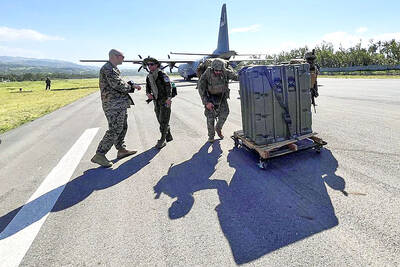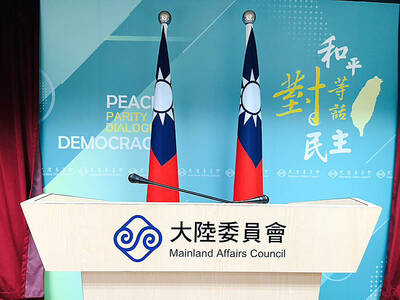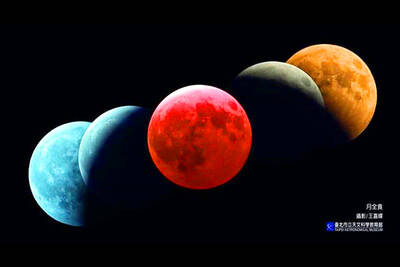China’s frequent missions near Taiwan during the past few months are part of Chinese officials’ overall strategy of influencing the nation’s public opinion, according to analysts in Taiwan.
The People’s Liberation Army (PLA) forces passed near Taiwan on deep-ocean training exercises 25 times from August to December last year, the Ministry of National Defense said in its year-end report last month.
By contrast, the PLA annually conducted four such training missions during the preceding few years. When Taiwan, Japan and South Korea began reporting on the missions, Chinese media also began to cover them, making comments about China’s right to carry them out.
Following exercises on Nov. 22 and 23, the PLA’s official account on messaging service Weibo showed Chinese Xian H-6K bombers flying within view of a mountain range that China’s Sina military news service claimed to be Taiwan’s Yushan (玉山).
After the PLA Air Force flew over Japan’s Miyako Strait and over the Bashi Channel on Dec. 12, more photos appeared on the PLA’s Weibo channel alongside a report saying that similar routine training exercises are to be the norm in the future. The report also differed from past PLA reports in that it specifically mentioned “encircling the island.”
The report asked readers: “Guess what island we encircled?” The accompanying pictures showed bombers joined by a formation of Shenyang J-11 fighters.
The PLA announced on Dec. 18 that bombers, fighters and reconnaissance aircraft would be passing over the Tsushima Strait toward international waters off the coast of eastern Japan to test their combat capability over long distances.
Lin Ying-yu (林穎佑), assistant professor at National Chung Cheng University’s Institute of Strategic and International Affairs, on Wednesday said the PLA is attempting to cause social disturbances in Taiwan by reporting on its activities.
Reports that mix true and falsified information will appear with increasing frequency, Lin said.
Communists have been using propaganda since the Chinese Civil War, Lin said, adding that the advent of the digital age has resulted in a “digital cold war.”
They are especially adept at using propaganda since they maintain full control over the media and over Internet use in China, he said.
China’s propaganda campaign has an internal front, which has been focusing on the corruption crackdown to show the Chinese public how much power the PLA holds, and an external front, which can be seen in the recent Weibo posts about military exercises and is aimed at Taiwan, Lin said.
With the frequent and close interactions today between people on both sides of the Strait, it is particularly easy for China’s “Internet army” (五毛黨) to spread false information on social media platforms and cause panic among Taiwanese netizens, Lin said.
The Chinese Communist Party first made mention of its intention to focus more on ideological warfare in 2014, at the time saying: “Future battles will not be won in the air; rather, military strategists will have to vie for control over the battlefields of public discourse and control of unseen public opinion.”
Whether the PLA’s actions represent routine exercises or preparation for war, the ministry is always ready for action, Ministry of National Defense spokesman Major General Chen Chung-chi (陳中吉) said.
“We neither fear war, nor ask for war,” Chen said. “We have the confidence and the ability to protect the safety of the nation’s territory.”
“There is no need to feel restless over a few pictures,” he added.

Three batches of banana sauce imported from the Philippines were intercepted at the border after they were found to contain the banned industrial dye Orange G, the Food and Drug Administration (FDA) said yesterday. From today through Sept. 2 next year, all seasoning sauces from the Philippines are to be subject to the FDA’s strictest border inspection, meaning 100 percent testing for illegal dyes before entry is allowed, it said in a statement. Orange G is an industrial coloring agent that is not permitted for food use in Taiwan or internationally, said Cheng Wei-chih (鄭維智), head of the FDA’s Northern Center for

LOOKING NORTH: The base would enhance the military’s awareness of activities in the Bashi Channel, which China Coast Guard ships have been frequenting, an expert said The Philippine Navy on Thursday last week inaugurated a forward operating base in the country’s northern most province of Batanes, which at 185km from Taiwan would be strategically important in a military conflict in the Taiwan Strait. The Philippine Daily Inquirer quoted Northern Luzon Command Commander Lieutenant General Fernyl Buca as saying that the base in Mahatao would bolster the country’s northern defenses and response capabilities. The base is also a response to the “irregular presence this month of armed” of China Coast Guard vessels frequenting the Bashi Channel in the Luzon Strait just south of Taiwan, the paper reported, citing a

UNDER PRESSURE: The report cited numerous events that have happened this year to show increased coercion from China, such as military drills and legal threats The Chinese Communist Party (CCP) aims to reinforce its “one China” principle and the idea that Taiwan belongs to the People’s Republic of China by hosting celebratory events this year for the 80th anniversary of the end of World War II, the “retrocession” of Taiwan and the establishment of the UN, the Mainland Affairs Council (MAC) said in its latest report to the Legislative Yuan. Taking advantage of the significant anniversaries, Chinese officials are attempting to assert China’s sovereignty over Taiwan through interviews with international news media and cross-strait exchange events, the report said. Beijing intends to reinforce its “one China” principle

A total lunar eclipse, an astronomical event often referred to as a “blood moon,” would be visible to sky watchers in Taiwan starting just before midnight on Sunday night, the Taipei Astronomical Museum said. The phenomenon is also called “blood moon” due to the reddish-orange hue it takes on as the Earth passes directly between the sun and the moon, completely blocking direct sunlight from reaching the lunar surface. The only light is refracted by the Earth’s atmosphere, and its red wavelengths are bent toward the moon, illuminating it in a dramatic crimson light. Describing the event as the most important astronomical phenomenon